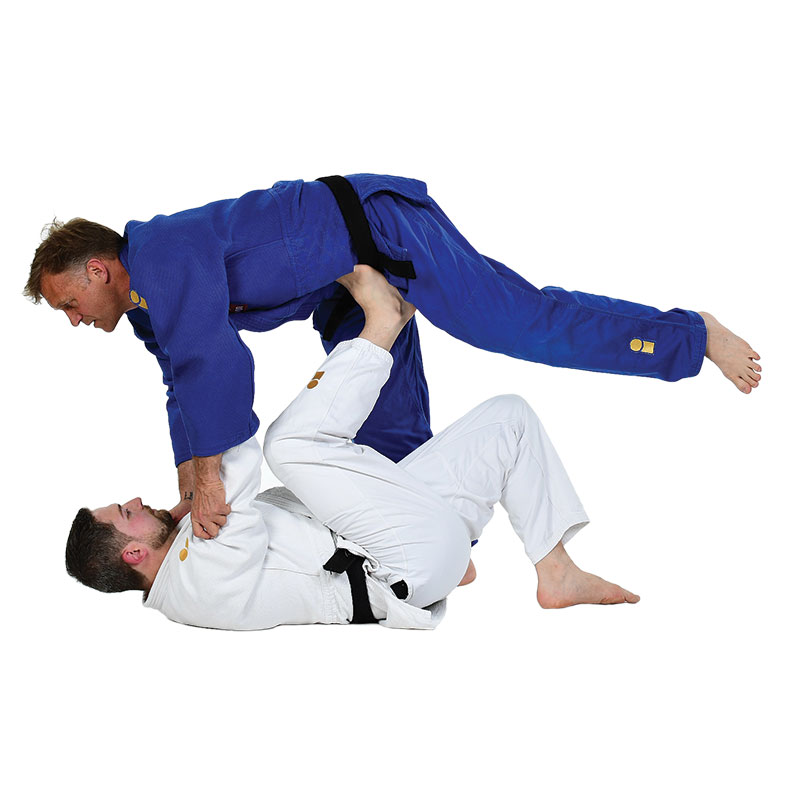Tomoe-nage 巴投 (“Circular Throw”)
Category: Ma-sutemi-waza (Rear Sacrifice Techniques)
Translation: “Tomoe” refers to a comma-shaped swirl or spiral, symbolising circular motion; “nage” means throw — together: circular throw.
Description
Tomoe-nage is one of the most iconic and elegant throws in judo. It exemplifies the principle of ju (gentleness or yielding) by using minimal force to redirect an opponent’s momentum.
Tori breaks uke’s balance forward or to the front-right diagonal (kuzushi), then drops backwards while placing a foot (usually the right) into uke’s lower abdomen or belt knot area. With a powerful lifting and pulling motion, tori uses his leg to propel uke in an arcing trajectory over his head, completing the throw in a rolling fashion.
This throw is especially effective when uke is aggressive or moving forward with momentum. Because it involves both players going to the ground and uke being projected over the head, it requires a high degree of control and precise ukemi (falling technique). For safety reasons, it is not permitted in competition for judoka under 12 years of age.

Biomechanics of Tomoe-nage
-
Classification: Lever throw combined with a couple force
-
Type of throw: Rear sacrifice (ma-sutemi)
-
Support point (C): Tori’s foot planted against uke’s lower abdomen or belt knot
-
Force dynamics:
-
F1 & F2: Tori’s arms pull uke forward and help steer the trajectory
-
F3: The planted foot exerts an upward force to lift uke’s centre of gravity
-
Re: The resultant direction of the throw, following a curved or circular path
-
-
Additionally, centrifugal force plays a role as uke rotates in an arc over tori.

Did you know?
-
Tomoe-nage was one of Jigoro Kano’s personal specialties. As a smaller man, he developed and relied on techniques that could manipulate larger opponents using timing, positioning and leverage.
-
The throw is derived from Tenjin Shinyo-ryu, one of the classical jujutsu styles Kano studied before founding judo. In its original form, it was known as Ando-gaeshi, named after Master Ando, who was known for his skill in using this motion to reverse opponents.
-
Kano later adapted and refined the technique to fit judo’s educational and sportive framework, making it safer and more technically structured, and renamed it Tomoe-nage.
-
The kanji 巴 (tomoe) refers to a swirling or comma-shaped design, often used in samurai crests (kamon) and Shinto shrines, symbolising cycles, movement, and balance. This reflects the circular nature of the technique.
-
Tomoe-nage demonstrates that a well-timed sacrifice using rotational mechanics can neutralise superior size or strength, a core principle in judo’s philosophy.
-
The throw is the first technique in the fourth group (Dai Yonkyo) of the Gokyo no Waza, the traditional syllabus of Kodokan Judo.
-
Tomoe-nage appears as the final throw in the Nage-no-Kata, the formal throwing kata, symbolising the culmination of skill, control and timing in judo.
Methodical Progression
Below are structured practice methods to help judoka isolate and master components of the technique.
Renraku-waza 連絡技 – Combinations in Opposite Directions
Renraku-waza, or “linking techniques”, involve combining throws in opposite directions. If the first attack is resisted or partially defended, tori redirects the movement and executes a second throw in the opposite direction. This approach is highly effective for breaking uke’s defence and regaining initiative.
Renzoku-waza 連続技 – Combinations in the Same Direction
Renzoku-waza refers to consecutive techniques that follow the same direction of movement, progressively unbalancing uke until a throw is achieved. While less discussed explicitly, this principle is widely used in randori and shiai to maintain pressure and rhythm.
Combinations
Deel 1
Kaeshi-waza 返し技 – Counter Techniques
Kaeshi-waza refers to counter-throws where tori reverses uke’s attack using timing and redirection. The key elements include:
- Exploiting Unbalance: Uke becomes temporarily unstable during their attack. Tori uses this moment to counter.
- Redirecting Force: Rather than resisting, tori guides uke’s force into a vulnerable angle.
- Blending with Movement: By moving with uke’s attack, tori stays in control and prepares a reversal.
These counters are fundamental to tactical judo and emphasize using uke’s momentum against them.